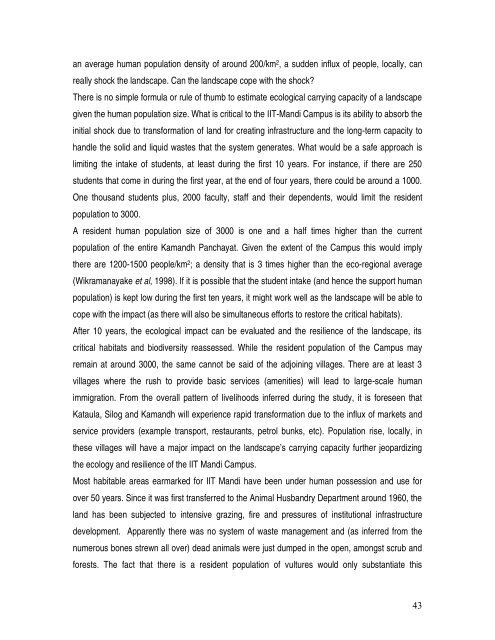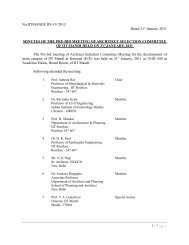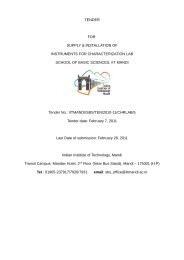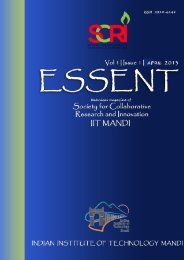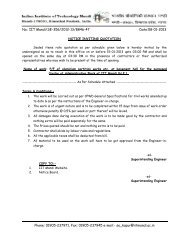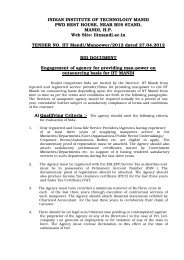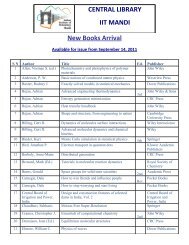Eco Report of the area - IIT Mandi
Eco Report of the area - IIT Mandi
Eco Report of the area - IIT Mandi
You also want an ePaper? Increase the reach of your titles
YUMPU automatically turns print PDFs into web optimized ePapers that Google loves.
an average human population density <strong>of</strong> around 200/km 2 , a sudden influx <strong>of</strong> people, locally, can<br />
really shock <strong>the</strong> landscape. Can <strong>the</strong> landscape cope with <strong>the</strong> shock<br />
There is no simple formula or rule <strong>of</strong> thumb to estimate ecological carrying capacity <strong>of</strong> a landscape<br />
given <strong>the</strong> human population size. What is critical to <strong>the</strong> <strong>IIT</strong>-<strong>Mandi</strong> Campus is its ability to absorb <strong>the</strong><br />
initial shock due to transformation <strong>of</strong> land for creating infrastructure and <strong>the</strong> long-term capacity to<br />
handle <strong>the</strong> solid and liquid wastes that <strong>the</strong> system generates. What would be a safe approach is<br />
limiting <strong>the</strong> intake <strong>of</strong> students, at least during <strong>the</strong> first 10 years. For instance, if <strong>the</strong>re are 250<br />
students that come in during <strong>the</strong> first year, at <strong>the</strong> end <strong>of</strong> four years, <strong>the</strong>re could be around a 1000.<br />
One thousand students plus, 2000 faculty, staff and <strong>the</strong>ir dependents, would limit <strong>the</strong> resident<br />
population to 3000.<br />
A resident human population size <strong>of</strong> 3000 is one and a half times higher than <strong>the</strong> current<br />
population <strong>of</strong> <strong>the</strong> entire Kamandh Panchayat. Given <strong>the</strong> extent <strong>of</strong> <strong>the</strong> Campus this would imply<br />
<strong>the</strong>re are 1200-1500 people/km 2 ; a density that is 3 times higher than <strong>the</strong> eco-regional average<br />
(Wikramanayake et al, 1998). If it is possible that <strong>the</strong> student intake (and hence <strong>the</strong> support human<br />
population) is kept low during <strong>the</strong> first ten years, it might work well as <strong>the</strong> landscape will be able to<br />
cope with <strong>the</strong> impact (as <strong>the</strong>re will also be simultaneous efforts to restore <strong>the</strong> critical habitats).<br />
After 10 years, <strong>the</strong> ecological impact can be evaluated and <strong>the</strong> resilience <strong>of</strong> <strong>the</strong> landscape, its<br />
critical habitats and biodiversity reassessed. While <strong>the</strong> resident population <strong>of</strong> <strong>the</strong> Campus may<br />
remain at around 3000, <strong>the</strong> same cannot be said <strong>of</strong> <strong>the</strong> adjoining villages. There are at least 3<br />
villages where <strong>the</strong> rush to provide basic services (amenities) will lead to large-scale human<br />
immigration. From <strong>the</strong> overall pattern <strong>of</strong> livelihoods inferred during <strong>the</strong> study, it is foreseen that<br />
Kataula, Silog and Kamandh will experience rapid transformation due to <strong>the</strong> influx <strong>of</strong> markets and<br />
service providers (example transport, restaurants, petrol bunks, etc). Population rise, locally, in<br />
<strong>the</strong>se villages will have a major impact on <strong>the</strong> landscape’s carrying capacity fur<strong>the</strong>r jeopardizing<br />
<strong>the</strong> ecology and resilience <strong>of</strong> <strong>the</strong> <strong>IIT</strong> <strong>Mandi</strong> Campus.<br />
Most habitable <strong>area</strong>s earmarked for <strong>IIT</strong> <strong>Mandi</strong> have been under human possession and use for<br />
over 50 years. Since it was first transferred to <strong>the</strong> Animal Husbandry Department around 1960, <strong>the</strong><br />
land has been subjected to intensive grazing, fire and pressures <strong>of</strong> institutional infrastructure<br />
development. Apparently <strong>the</strong>re was no system <strong>of</strong> waste management and (as inferred from <strong>the</strong><br />
numerous bones strewn all over) dead animals were just dumped in <strong>the</strong> open, amongst scrub and<br />
forests. The fact that <strong>the</strong>re is a resident population <strong>of</strong> vultures would only substantiate this<br />
43


